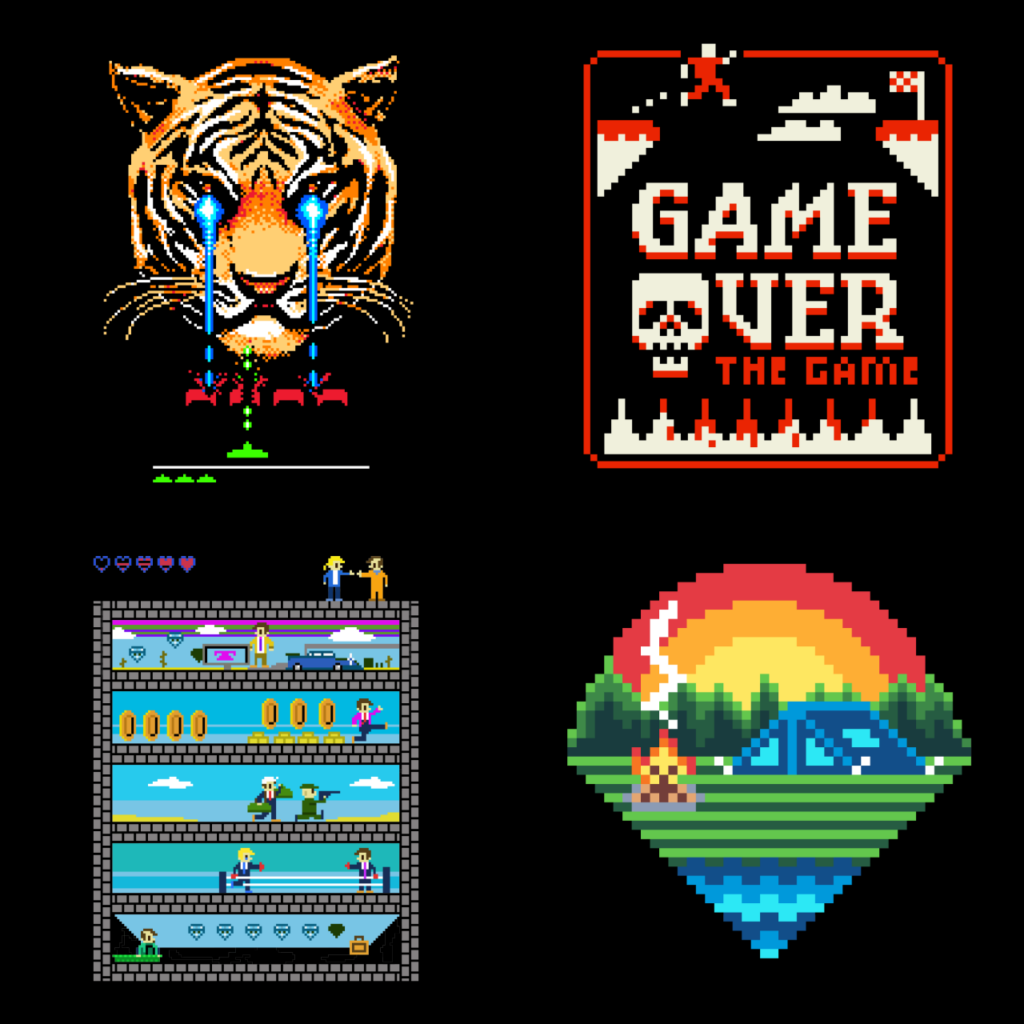In the vast sea of digital art, one style resurfaces with a nostalgic charm that captures the heart of both creators and consumers alike: retro-style pixel art. This distinctive form, reminiscent of the early days of video gaming, has made a striking comeback in modern design, including Threadless’s vibrant marketplace. Understanding and incorporating this trend in your own Artist Shop is more than a nod to the past, it’s a way to connect with an audience that cherishes both nostalgia and innovation.
The Genesis of Pixel Art
Pixel art’s blocky beginnings are intertwined with the early days of video gaming in the late 1970s and early 1980s, when technical constraints limited graphical capabilities. Iconic games such as Space Invaders (1978) and Pac-Man (1980) were among the first to utilize pixel art out of necessity, creating compelling visuals that captivated players worldwide. This era set the foundation for pixel art, turning these limitations into a unique and recognizable style that resonated deeply with the gaming community.

As technology advanced, pixel art evolved, reaching its zenith during the 16-bit era of the early 1990s with classics like Street Fighter II (1991) and Chrono Trigger (1995). These games demonstrated the potential of pixel art to create intricate and vibrant worlds, pushing the boundaries of digital storytelling within the constraints of pixel-based graphics. This period highlighted the artistic possibilities of pixel art, making it a hallmark of video game design.
Despite the shift towards 3D graphics in the late 1990s, pixel art remained a beloved aesthetic, experiencing a resurgence with the indie game boom of the late 2000s. Games such as Minecraft (2011) and Stardew Valley (2016) embraced pixel art, celebrating its nostalgic appeal while showcasing its ongoing relevance and adaptability. Today, pixel art continues to influence a wide range of digital media, proving its lasting legacy as a distinctive and enduring form of artistic expression.
Design Like It’s 1989: How to Channel This Aesthetic
Retro-style pixel art is defined by its unique, grid-based construction, where each pixel serves as a building block for intricate designs. This style is characterized by its limited color palettes, which challenge artists to create compelling images within constraints. From the classic 8-bit and 16-bit styles to isometric and beyond, pixel art offers a variety of expressions, each with its own charm and challenges. Drawing inspiration from the video games and digital art of yesteryears, today’s pixel art thrives on both nostalgia and innovation.

For those wondering how to create pixel art, starting can be as simple as choosing the right tools. Software like Adobe Photoshop, Aseprite, or even the humble Microsoft Paint can be your gateway into pixel art creation. The key principles of pixel art include careful color selection, pixel precision, and embracing the pixel grid.
When it comes to capturing the spirit of pixel art, here are a few characteristics that draw fans to the aesthetic:
- Its charm is in it’s simplicity. This design style strips back the complexity and focuses on the basics. It’s a refreshing break from the hyperrealistic visuals that modern entertainment inundates us with every day.
- It’s a celebration of the past. Pixel art leverages the fond memories many hold for the early days of video gaming—the ‘start’ screens that greeted us, the cartridges we exchanged, and the simple joy of pixelated adventure.
- It sparks the imagination. This trend isn’t just about recreating the games of the past, but also imagining the games that never were. It’s your playground to invent new worlds, characters, and stories, all within the pixel art style.
Experimentation within this style not only enhances your skills but also leads to unique and captivating designs. As you delve into pixel art, remember that the beauty of this form lies in its simplicity and the stories you can tell within these digital squares.
Leveling Up Your Shop’s Merch
Identifying and understanding your target audience is the first crucial step in turning your pixel art into successful merch. The nostalgic charm and retro appeal of pixel art often resonate most strongly with gamers, tech enthusiasts, and lovers of vintage aesthetics. These groups are likely to appreciate the authenticity and creativity of pixel art, seeing it not just as a design but as a piece of digital culture and history.

The next key strategy is selecting the right products to feature your pixel art. Gamers, for instance, might be particularly drawn to merchandise that reflects their passion and integrates into their lifestyle. T-shirts featuring 8-bit characters, art prints that celebrate iconic gaming moments, mouse pads with vibrant pixel landscapes, and stickers of pixelated heroes can transform ordinary items into collectibles and conversation pieces. Each product offers a unique canvas for pixel art, allowing artists to connect with their audience in a personal and practical way.
How to Market Your Pixel Art

Marketing your merch effectively involves leveraging platforms and communities where your audience congregates. Social media platforms, gaming forums, and retro gaming events are excellent venues to showcase your work. Engaging with your audience through these channels, sharing the stories behind your designs, and demonstrating your passion for pixel art can help build a loyal following. Collaborations with gaming influencers, participation in online art communities, and promotions on platforms dedicated to retro and indie games can further amplify your reach, turning your pixel art creations into not just merchandise, but treasured pieces of pop culture.
The resurgence of retro-style pixel art in modern design is more than a trend, it’s a testament to the enduring appeal of digital creativity and nostalgia. For Artist Shop owners on Threadless, exploring how to create pixel art and integrating it into your offerings can open up new avenues for expression and connection with your audience. Dive into the pixelated world, and let the simplicity and charm of pixel art elevate your designs.


